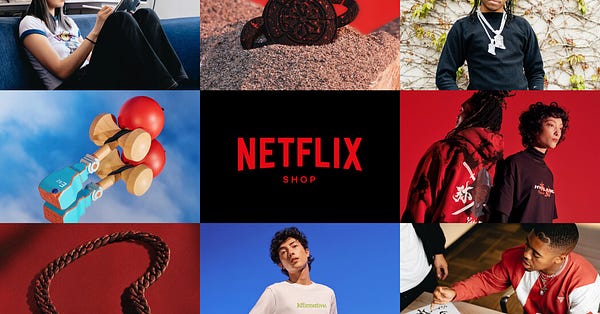Mic Drop #32: Netflix.Shop Solves More for Netflix Than Commerce
How The PARQOR Hypothesis & Malcom Gladwell's "Hush Puppy Boom" case study help to explain Netflix's new commerce strategy
It’s been an unusually Netflix-heavy news week. So, this week’s PARQOR mailings will end up being unusually Netflix-heavy.
A week after reporting confirmed that Netflix has been exploring a gaming service (which I wrote about in Member Mailing #266: Netflix & Verizon Test Bundling Streaming with Gaming), Netflix announced Netflix.shop, an online store that features products inspired by shows on its streaming platform.
Both stories reflect Netflix addressing a weakness in its model that the PARQOR Hypothesis helps to highlight: it lacks multiple Avenues to monetizing the same IP.


Netflix gets 2.5 out of 5 checkmarks in the BEADS acronym:
❌ an Aspirational Brand
✅ Existing user base at scale
❌ Multiple Avenues to monetizing the same IP, and
✅ Daily value proposition (something new for fans to consume daily)
Sales Channels: ✅ Online (digital) and ❌ offline (physical) commerce
An online store, gaming, an upcoming push into podcasts, and a “Drive-Into Experience” with Stranger Things in Los Angeles, CA are all incremental steps towards solving for multiple Avenues to monetizing the same IP.
Netflix.shop will be in the US, only, before expanding into other countries around the world “in the coming months”.
Netflix.Shop is a broader solution
But, as this New York Times piece “Netflix: The Store” highlights, Netflix.Shop is solving for more than just the A of the BEADS acronym.
First, it solves for offline (physical) commerce Sales channel by securing distribution in retail chains like Walmart, Sephora, and Target:
The site is the next logical step for a company that has gotten serious about the retail business in the last year, an effort led by the executive Josh Simon, who runs Netflix’s consumer products division.
Mr. Simon joined the company in March 2020 after working in a similar role at Nike. On his watch, the consumer products team has grown to 60 people, from 20, and Netflix has made deals with Walmart, Sephora, Amazon and Target to sell clothes, toys, beauty kits and housewares, among other items, related to its series and films.
However, The New York Times also reports Netflix will not have stores of its own:
Unlike Disney, which is estimated to generate tens of billions of dollars in sales each year in merchandise, Netflix has no plans for brick-and-mortar stores in malls or Times Square.
Second, Netflix.Shop is taking multiple steps to solve for the B of the BEADS acronym: an aspirational Brand. Netflix announced it is” introducing a collection of anime-inspired collectibles from a remarkable group of up-and-coming designers: Nathalie Nguyen, Kristopher Kites and Jordan Bentley.” It will also be introducing a new Netflix logo-wear from Japanese fashion house BEAMS (NOTE: and before you ask, the coincidence of BEAMS helping to illustrate BEADS is not lost on me).
Netflix & The Hush Puppy Boom
I think Netflix’s bets on these “aspirational” designer brands is an attempt to mirror the business logic of the “Hush Puppy Boom” discussed in Malcolm Gladwell’s The Tipping Point (read the excerpt of the case study in The Guardian here). As Gladwell writes, “in order to create one contagious movement, you often have to create many small movements first.”
The partnership with Jordan Bentley and his Hypland brand is a perfect example of solving for aspirational brand:
“He’s part of that drop culture, where kids are lining up on Fairfax Avenue in Los Angeles to buy his products,” Mr. Simon said.
Drop culture is hush puppy booms on an ongoing, repeat micro-basis: product releases with little or no warning, in limited quantities via limited retailers, and promoted aggressively via social media. It’s many small movements with the objective of driving a broader “contagious” movement around a brand. It’s what has helped to build the Hypland brand.
Drop culture’s release cycles map to Netflix’s content release schedule of multiple releases on a repeat, micro-basis over the course of a year (768 through June 1st, according to What’s On Netflix’s Kasey Moore). But, Netflix.Shop helps to turn those movies and series into aspirational IP for the more fashion-oriented in its subscriber base of 205MM+ worldwide, and 68MM (est.) in the U.S.
According to the New York Times, it also can turn those subscribers into entrepreneurial brand evangelists:
Thousands of fan-made products related to the Netflix documentary series “Tiger King,” including candles, face masks and greeting cards, are on sale at Etsy and similar sites, without the company’s blessing.
Conclusion
The PARQOR Hypothesis helps to flag the broader implications of Netflix.Shop:
It creates multiple Aspirational Brands for Netflix, though at a smaller scale
It builds upon Netflix’s aggressive release schedule to build ongoing and expanding smaller avenues to monetizing its IP, and
It puts Netflix in offline retail shops without Netflix needing to build or own brick-and-mortar
An e-commerce-first strategy targeted to an existing user base at scale is unusually cost-effective to manage:
marketing costs are low
the store can be built off of Netflix’s enormous existing cloud infrastructure (at minimal extra costs)
without brick-and-mortar retail, there is no need for taking on long, expensive leases or additional staff salaries
The highest cost appears to be a revenue share with designers. With operating costs unusually low and an existing user base at scale, Netflix.Shop could solve for these three weaknesses AND turn out to be a big ROI win for Netflix.
The PARQOR Hypothesis suggests that the Netflix.Shop is a bigger bet than the marketplace appears to realize.
Read more about The PARQOR Hypothesis on PARQOR.com.




